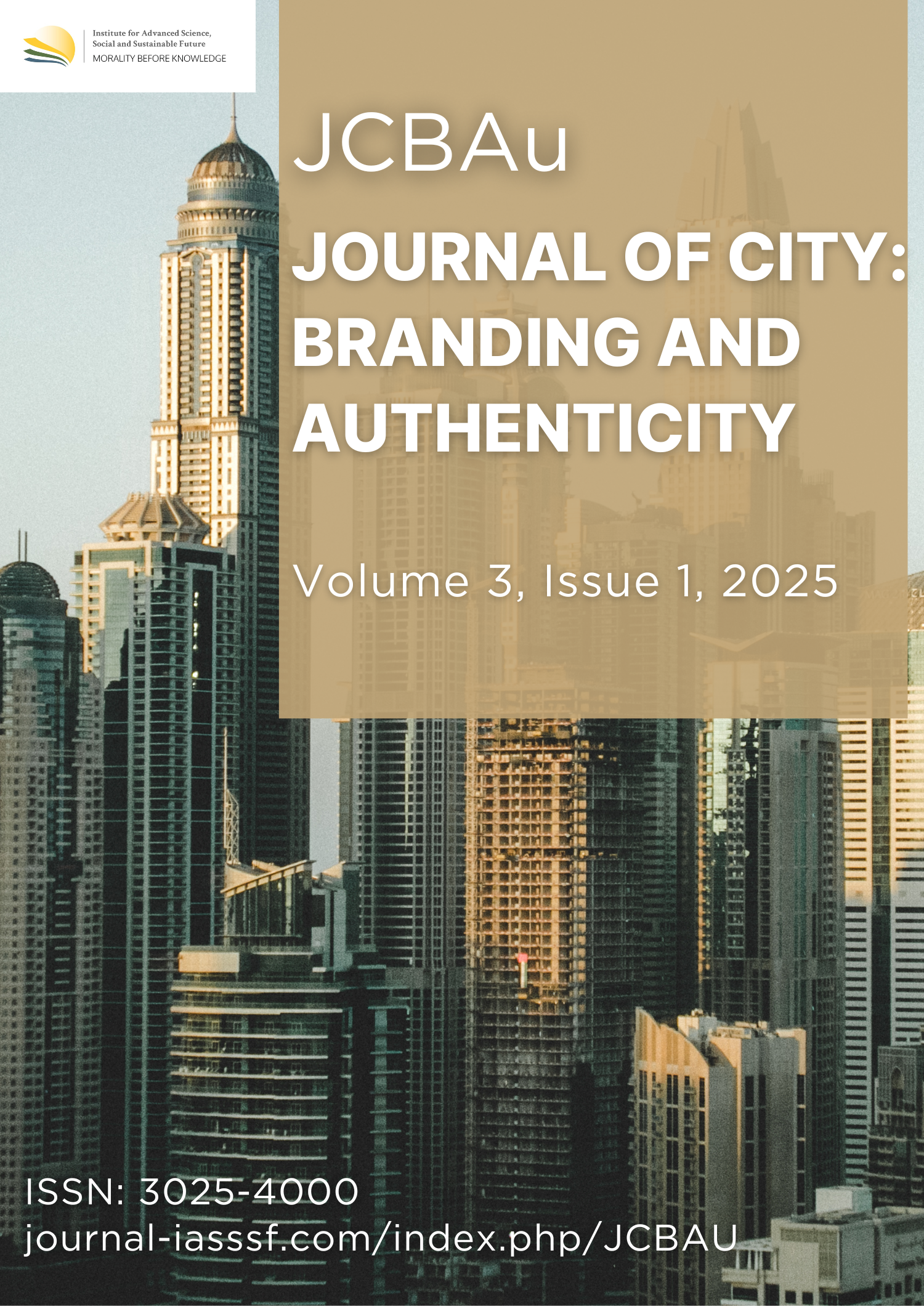Experiential authenticity and spatial psychology: A Human-centered reading of the Jewish Museum Berlin
DOI:
https://doi.org/10.61511/jcbau.v3i1.2025.2150Keywords:
city branding, embodied memory, experiential authenticity, human-centered design, Jewish Museum Berlin, spatial psychology, trauma architectureAbstract
Background: The Jewish Museum Berlin, designed by Daniel Libeskind, exemplifies a shift in contemporary museum architecture, where spatial design becomes a narrative tool to address cultural trauma and shape collective memory. As cities increasingly compete on cultural identity, architecture plays a growing role in city branding and emotional engagement. Methods: This study employs a mixed-methods approach, integrating qualitative interpretive analysis with quantitative survey data. Thematic coding using NVivo was applied to open-ended visitor responses, while descriptive statistics were used to analyze Likert-scale responses from 100 participants. Findings: Architectural features such as voids, fragmented pathways, and disorienting circulation elicit strong emotional engagement and embodied memory. These spatial experiences enhance the perceived authenticity of the museum and reinforce Berlin’s identity as a city of remembrance. Visitors rated the museum highly for emotional authenticity (M=4.29, SD=1.25; 71% agreement). Perceived authenticity strongly correlated with emotional engagement (r = 0.65, p <0.01) and with Berlin’s identity as a city of remembrance (r=0.71, p <0.01). High mean scores for embodied experience (up to M=4.46; 94% agreement) indicate that voids, tilted floors, and immersive acoustics evoke disorientation, reflection, and sensory resonance. NVivo coding reinforced these quantitative trends, revealing recurring themes of emotional immersion, embodied memory, authenticity, and urban identity reflection. Conclusion: Spatial and sensory design in the Jewish Museum Berlin contributes to emotionally authentic experiences that align with and strengthen Berlin’s urban identity and cultural narrative. Novelty/Originality of this article: This study contributes a human-centered analysis of how trauma-informed architecture can produce experiential authenticity and support city branding. By combining emotional psychology, spatial design theory, and urban identity, the paper offers a new interdisciplinary lens on affective architecture.
References
Ameri, A. (2004). The spatial dialectics of authenticity. SubStance, 33(2), 61-89. https://doi.org/10.1353/sub.2004.0016
Böhme, G. (2017). Atmospheric architectures: The aesthetics of felt spaces. Bloomsbury Publishing.
Boyer, M. C. (1996). The City of Collective Memory. https://mitpress.mit.edu/9780262522113/the-city-of-collective-memory/
Casey, E. S. (2000). Edward S. Casey, Remembering, Second Edition: A Phenomenological Study—PhilPapers. https://philpapers.org/rec/CASRAP/
Handler, R. (2014). Authenticity-AT-1986. https://is.muni.cz/el/1423/podzim2015/SOC310/crd/jar/aut/Handler-Authenticity-AT-1986.pdf
Hansen-Glucklich, J. (2010). Embodying Memory at the Jewish Museum Berlin. Religion and American Culture: A Journal of Interpretation, 20(2), 187–219. https://www.h-net.org/reviews/showpdf.php?id=41380
Hansen-Glucklich, J. (2014). Holocaust memory reframed: Museums and the challenges of representation. Rutgers University Press. https://www.jstor.org/stable/j.ctt5vjxq0
Huyssen, A. (2003). Present Pasts. Stanford University Press.
Jewish Museum Berlin. (n.d.). About the Architecture | Jewish Museum Berlin. https://www.jmberlin.de/en/topic-architecture
Libeskind, D. (2004). Breaking Ground: Adventures in Life and Architecture. Riverhead Books.
Lin, Y. C. (2020). Measuring authenticity through spatial metaphors: How close are touris ts to the back regions? Current Issues in Tourism, 24(11), 1561–1575. https://doi.org/10.1080/13683500.2020.1815668
Macdonald, S. (n.d.). Memorylands Heritage and Identity in Europe Today.
Macdonald, S. (2013). Memorylands: Heritage and identity in Europe today. Routledge. https://doi.org/10.4324/9780203553336
Norberg-Schulz, C. (1980). Genius loci by Christian Norberg-Schulz | Open Library.
Pallasmaa, J. (2024). The eyes of the skin: Architecture and the senses. John Wiley & Sons.
Rickly, J. M. (2018). Tourism geographies and the place of authenticity. Tourism Geographies, 20(4), 733–736. https://doi.org/10.1080/14616688.2018.1477169
Saindon B. A. (2012). A Doubled Heterotopia: Shifting Spatial and Visual Symbolism in the Jewish Museum Berlin’s Development. The Quarterly Journal of Speech, 98(1), 24–48. https://doi.org/10.1080/00335630.2011.638657
Simonsson, M. (2012). Antecknat: På besök i Livias målade trädgård. Tankar kring analyser av rumsliga faktorer och autenticitet i utställningsmiljöer. Kulturella Perspektiv – Svensk Etnologisk Tidskrift, 21(2), 37–39. https://doi.org/10.54807/kp.v21.28054
Simonsson, M. (2014). Displaying Spaces: Spatial Design, Experience, and Authenticity in Mu seums.
Souto, A. (2018). Experiencing Memory Museums in Berlin. The Otto Weidt Workshop for the Blind Museum and the Jewish Museum Berlin. Museum & Society, 16(1), 1-27. https://irep.ntu.ac.uk/id/eprint/33181/
Studio Libeskin. (2001). Jewish Museum Berlin. Libeskind. https://libeskind.com/work/jewish-museum-berlin/
Trilling, L. (2009). Sincerity and authenticity. Harvard University Press.
Tsiftsi, X. (2018). Rethinking Authenticity of the Holocaust Experience Through Museum Architecture:“This is not a place of memory; this is a place of commemoration. Journal of Narrative and Language Studies, 6(10), 17-36. https://nalans.com/index.php/nalans/article/view/104
Tuan, Y.-F. (1977). Space And Place. https://www.upress.umn.edu/9780816638772/space-and-place/
Vavilova, Z. E. (2021). Social Inclusion Reflected in the Images of Modern Advertising. Logos et Praxis, 20(4), 100-108. https://doi.org/10.15688/lp.jvolsu.2021.4.10
Wang, N. (1999). Rethinking authenticity in tourism experience—ScienceDirect. https://doi.org/10.1016/S0160-7383(98)00103-0
Wesener, A. (2016). ‘This place feels authentic’: exploring experiences of authenticity of place in relation to the urban built environment in the Jewellery Quarter, Birmingham. Journal of Urban Design, 21(1), 67-83. https://doi.org/10.1080/13574809.2015.1106915
Zhang, Z., Lu, J., & Zhang, X. (2024a). Emotionally-oriented design in museums: a case study of the Jewish Museum Berlin. Frontiers in Psychology, 15, 1423466. https://doi.org/10.3389/fpsyg.2024.1423466
Zhang, J., Zou, Y., Li, Y., Peng, C., & Jin, D. (2024b). Embodied power: How do museum tourists’ sensory experiences affect place identity?. Journal of Hospitality and Tourism Management, 60, 334-346. https://doi.org/10.1016/j.jhtm.2024.08.009
Zukin, S. (2009). Naked city: The death and life of authentic urban places. Oxford University Press.
Downloads
Published
How to Cite
Issue
Section
Citation Check
License
Copyright (c) 2025 Shwun Thwet Htoo

This work is licensed under a Creative Commons Attribution 4.0 International License.
















